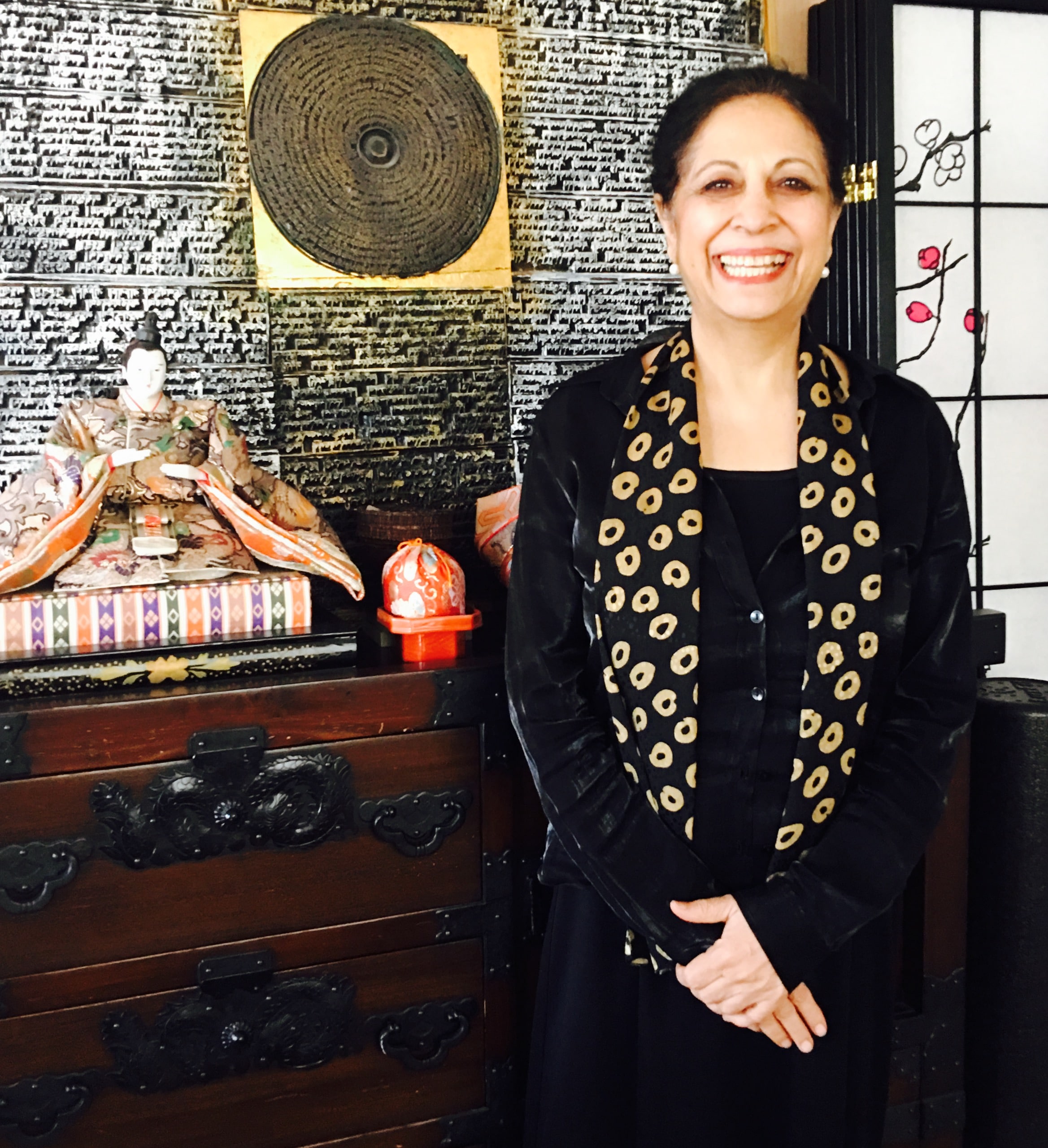
Geeta Mehta at home in New York, NY. June, 2017.
Geeta Mehta, an architect and urban planner, is the author of the upcoming book entitled Building Social Capital by Design (Columbia University Press) that highlights the importance of adding social capital to urban projects that are often considered in terms of financial capital alone.
Geeta is also the cofounder of two NGOs: URBZ and Asia Initiatives, and the innovator of Social Capital Credits, the community currency for social good. She spoke with impactmania about what drives sustainable social impact and why many current urban development trends adversely affect social capital.
Could you give me an example of how lives have been changed through Asia Initiatives?
We have been working with a group of women in Tamil Nadu for 15 years. The first time I met them, they had their heads covered, eyes down, and they wouldn’t even look up.
Working with our local partner, MSSRF, we formed self-help groups of 12 to 20 women of similar backgrounds — so they felt comfortable working with one another. Asia Initiatives started 200 micro credit banks, from which these participating women could take out loans for micro-businesses that they could start together. One of these groups started an enterprise to make paper out of banana plant waste. The idea came as a response to the lifecycle of banana trees. When a banana plant dies, once every five years or so, it leaves behind a stem that contaminates waterways and chokes creeks. This business used waste to create a product was a solution to this problem, and at the same time generated income for the group. We were very proud of them.
Now, eight years later, I still make an effort to visit this project in Tamil Nadu regularly. When I visited them in 2010, the women were much better dressed and smiling, with their heads held up high. We said, “Wow! This is amazing.”
When I visited them again three years ago, I said, “My God, now I’m even intimidated by these women!” [Laughs.] They had already collected money and purchased a piece of land next to the Knowledge Center, run by our partner, MSSRF, and wanted to build their own building. In fact, they had drafted a petition and collected signatures! Before this program, they couldn’t even sign their names — they had to use their thumbprints. Their chairperson came forward and gave an impressive speech saying, “Here is our petition — we want you to fund this because this will empower not only us, but all the women around us.” Two women in this group also ran for political office and got elected.
“This is truly wonderful,” I told them. “You don’t even need us any more! We need you to show other people what can be done.” So we made a video featuring them, called “15 Women.”
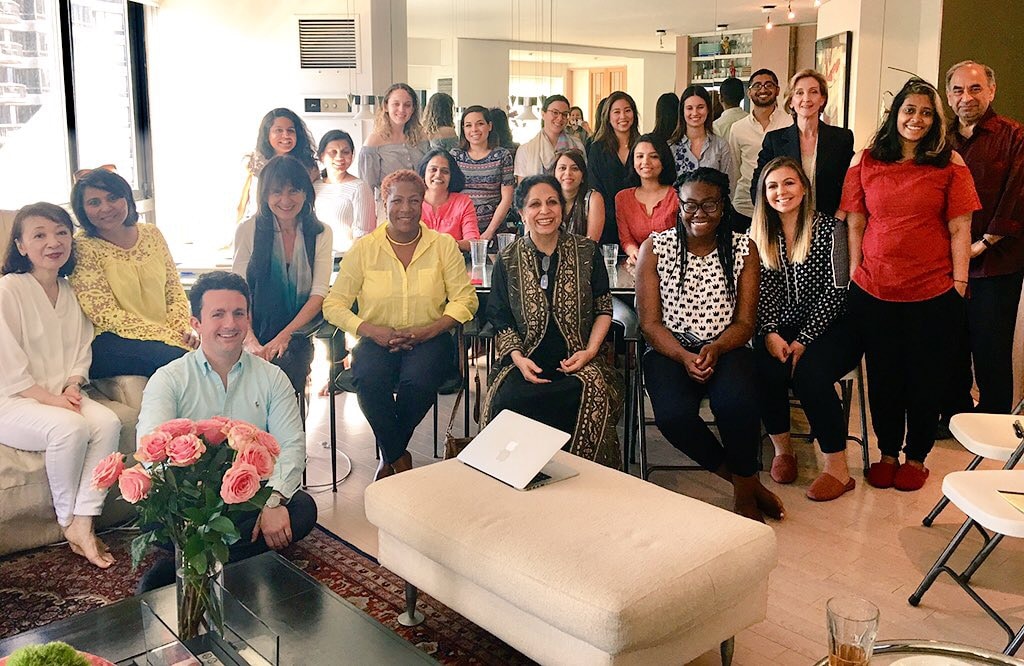
Geeta Mehta and the Asia Initiatives team. Photo by impactmania.
What have you learned in building Asia Initiatives? What has surprised you the most about the process?
The really big realization was that our economy and our world based upon hyper capitalism are set up wrong — all wrong.
We can see the results in income inequality all over the world. In the U.S., this has reached extreme proportions and the current administration is proposing cutting healthcare, education, and housing budgets, which is likely to make it worse.
The Housing and Urban Development Secretary, Ben Carson, recently called poverty a “state of mind.” This breaks my heart. We have to create a different system as a reference point, and so my research is focused on our other wealth — our social capital. Government policies and projects cannot be decided solely based on financial capital.
There has to be triple bottom line accounting for financial capital, social capital, and ecological capital. However, the big problem is how do you measure social capital? How can you leverage it to improve lives? The book I’m working on for Columbia University addresses these questions.
In 1970s, when environmental concerns began to be discussed, people were saying, “How will we ever measure pollution?” Today, we have very specific ways in which we do, and I think we are currently at that point in social capital.
Can you give me an example of how you measure social capital? What are some of the tools that you’re using to measure impact?
One of the tools we are proposing is to measure social interactions — like how many times a day did you meet somebody that you knew or didn’t know before. We measure the intensity of interactions and their lengths. You can understand that when you compare social capital building opportunities in Manhattan and the suburbs.
There are many problems in suburbs due to breakdown of social capital because people are isolated and there is very little sense of community. You can have your nice big house with a green lawn and your car and that’s it, right? You are not going to interact or rub shoulders with other people on a regular basis, which leads to loneliness and purposelessness in life.
Is there a breakdown of social capital in the United States?
Yes, in the United States, social capital is being lost at increasingly high rates. There is opioid abuse, high incarceration rates, and depression among demographics you would not expect it in. Why is that? Partly, it’s because the social networks are broken. [For example: “Since 1990, death rates for rural white women in midlife have risen by nearly 50 percent.”]
However, if you regularly interact in a community, you exchange ideas and affirmations and build trust and purpose in your life — that is how social capital is built. So, as an architect and an urban designer, I’m saying that cities are not only about new and tall buildings; cities are about the kind of spaces that will enable social interaction. Streets, public spaces, green areas, and parks — these are spaces where grandparents and children can go out and be in very pleasant and safe surroundings. That’s what the city should be.
But right now, we are not designing that city. Right now, we are designing a city “where we can make the most money or make the tallest buildings.”
How can an urban designer promote public good?
In this building that you can see from here, the white and black one, the penthouse sold for $100 million, right? That’s where money is made and those people have no interest in what happens on the ground, in the public realm.
Unfortunately, most governments do not seem to be concerned with that — although New York is one of the exceptions — I think the New York City Planning Department is extremely effective in promoting public interest. Urban designers and planners represent the public good and develop policies and guidelines to protect the city against excessive profit-seeking by developers.
That said, planning departments in most in developing countries just do not have that capacity. They are simply doing the bidding of wealthy people and developers. In this scenario of speculative urbanism, these governments are not custodians of public good anymore. Through my work and research we are challenging these priorities by saying, “Okay, let’s also put social capital into the project calculations, this is what the city needs, and this is how social capital is built or destroyed.”
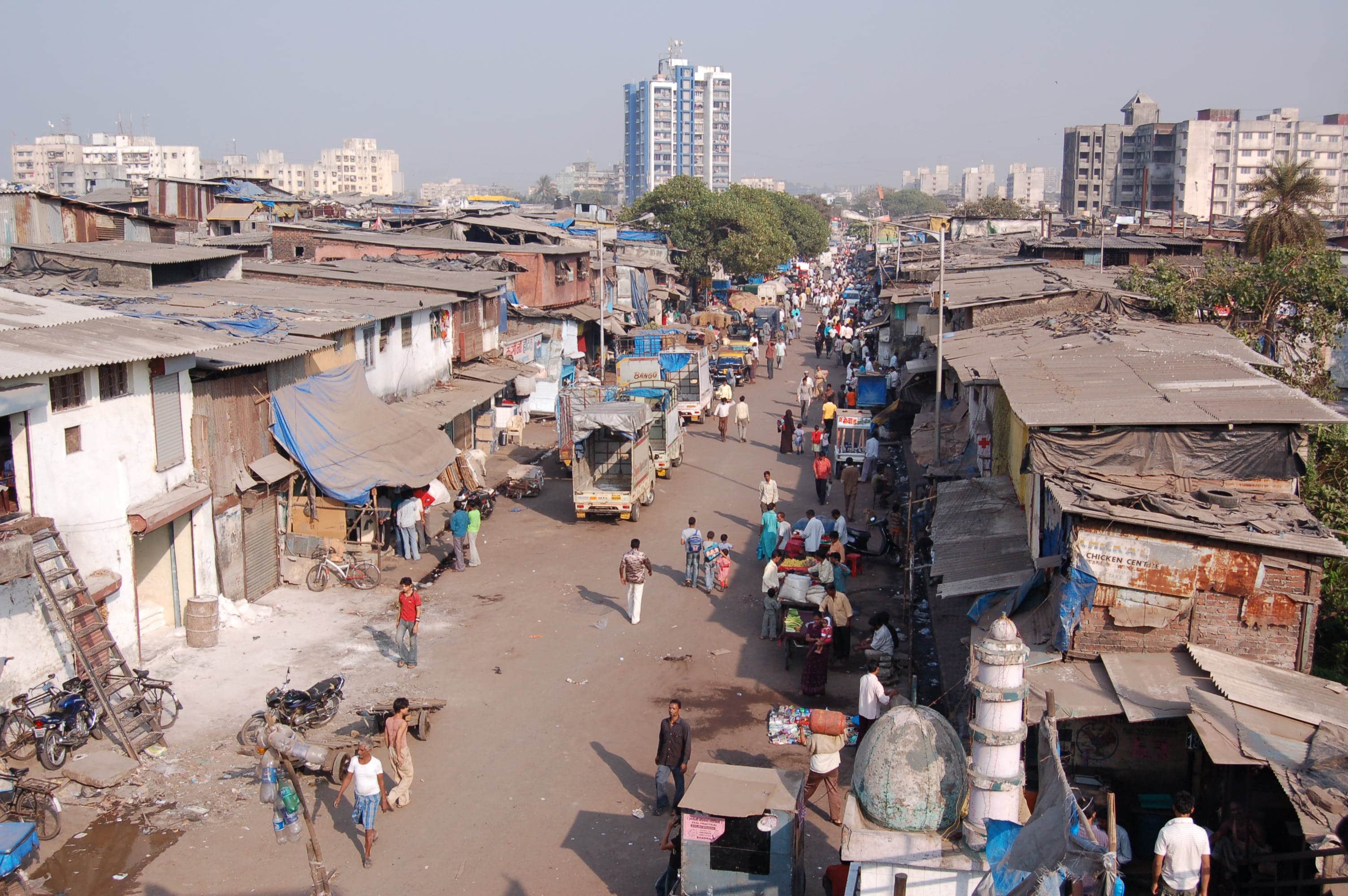
The streets of Dharavi in Mumbai, India.
In rapidly developing countries, if there is a slum in the middle of the city, the government is very keen to bulldoze it and have tall buildings for higher income groups built there. With URBZ: User-generated cities, the other nonprofit I co-founded, we have been working in Dharavi in Mumbai for nine years.
Originally, Dharavi, erroneously called a slum, was outside the city and the city grew around it, which made it prime real estate. Dharavi was going to be bulldozed, so we worked with the people there to redefine it not as a slum — but a craft village.” Fortunately, enough people and organizations also promoted this idea, so Dharavi’s importance within Mumbai was understood, and this contributed to it being saved.
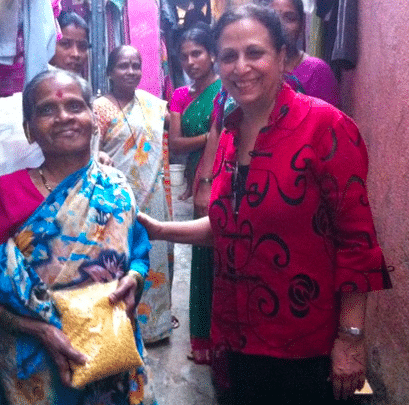
Geeta Mehta with resident in Dharavi involved with Social Capital Credits. There are 600,000 people living in Dharavi in roughly 90 distinct neighborhoods. These people supply the city with labor and inputs for industry, contributing 1 billion dollars into Mumbai’s economy.
Dharavi is a bustling area of craftsmen, potters, drivers, and service providers to the city. More than half of Mumbai’s waste is recycled here. They make handbags and shoes that are sold all over the world in high-end retail stores. They even make leather jackets that are sold in Saks Fifth Avenue and embroider clothes for GAP. New migrants get their first foothold in the city and their first incomes here.
Dharavi is a low-rise area of two or three story buildings — a place where mothers work while watching their children play on the street. And if a mother goes out to work, then a neighbor watches the children. There’s that sense of community. The government had a proposal to sweep all these people outside the city into tall buildings, and develop this area into an upscale, fashionable neighborhood, something like Hudson Yards in New York.
How could calculating social capital make a difference in Dharavi?
The question is what Dharavi’s social capital is worth to Mumbai, and what alternative could the government propose for the services Dharavi provides to the city, and for fresh migrants coming from outside to get a foothold and a social safety net in Mumbai?
Social capital value includes trust people have in each other, it includes a neighbor watching a child and people caring for others. Redevelopment decisions should be made keeping in mind such values. We had this conversation with the people in the village, too. As a result, the people of Dharavi developed a strong vocabulary they used in talking to the government and developers, and they succeeded in preventing the redevelopment that would have been detrimental to them from happening.
This shows that you cannot think of relocating people for real estate reasons alone. These are real people, with families, and communities. People in Dharavi actually resented [the film] Slum Dog Millionaire because they said, “It is misrepresentative of us; no child is abandoned like that here — we live in strong and distinct neighborhoods where people help each other.” Taking care of each other at the end of the day is what life is all about. It’s not about money — and this is the reason why we have to create an emphasis on social and ecological capital instead of thinking of financial capital alone.
Decision makers often don’t realize the unintended consequences of redevelopment or of moving people around just by looking at one set of numbers. Why do they assume that people want to live in a new high-rise rather than in a community they have built themselves? If the government provides people with tenure and infrastructure, they will improve their homes themselves, and no one will be able to call Dharavi a slum any more.
The social infrastructure and public spaces are key to so many people’s livelihoods and lifestyles in Dharavi. Vendors use the street to set up their push-carts, potters dry their pottery on the street, and kids play with each other there. Once you take that street and social space away from them and put them in a little apartment in a high rise, their livelihood could be gone, along with all their networks and social capital.
It’s not an Indian issue alone. URBZ ran a workshop on similar issues in Istanbul in the neighborhood of Şişhane, Galata, where people make electric lamps. Somebody there makes the lampshade, somebody does the wiring, somebody else does the assembly, and a beautiful lamp comes out. The Turkish government wanted to clear the area for more tourist amenities. A local group invited us to work with them and we emphasized that if you disperse these people, they would not be able to make these lamps anymore, and the city would loose a historic and vibrant craft community.
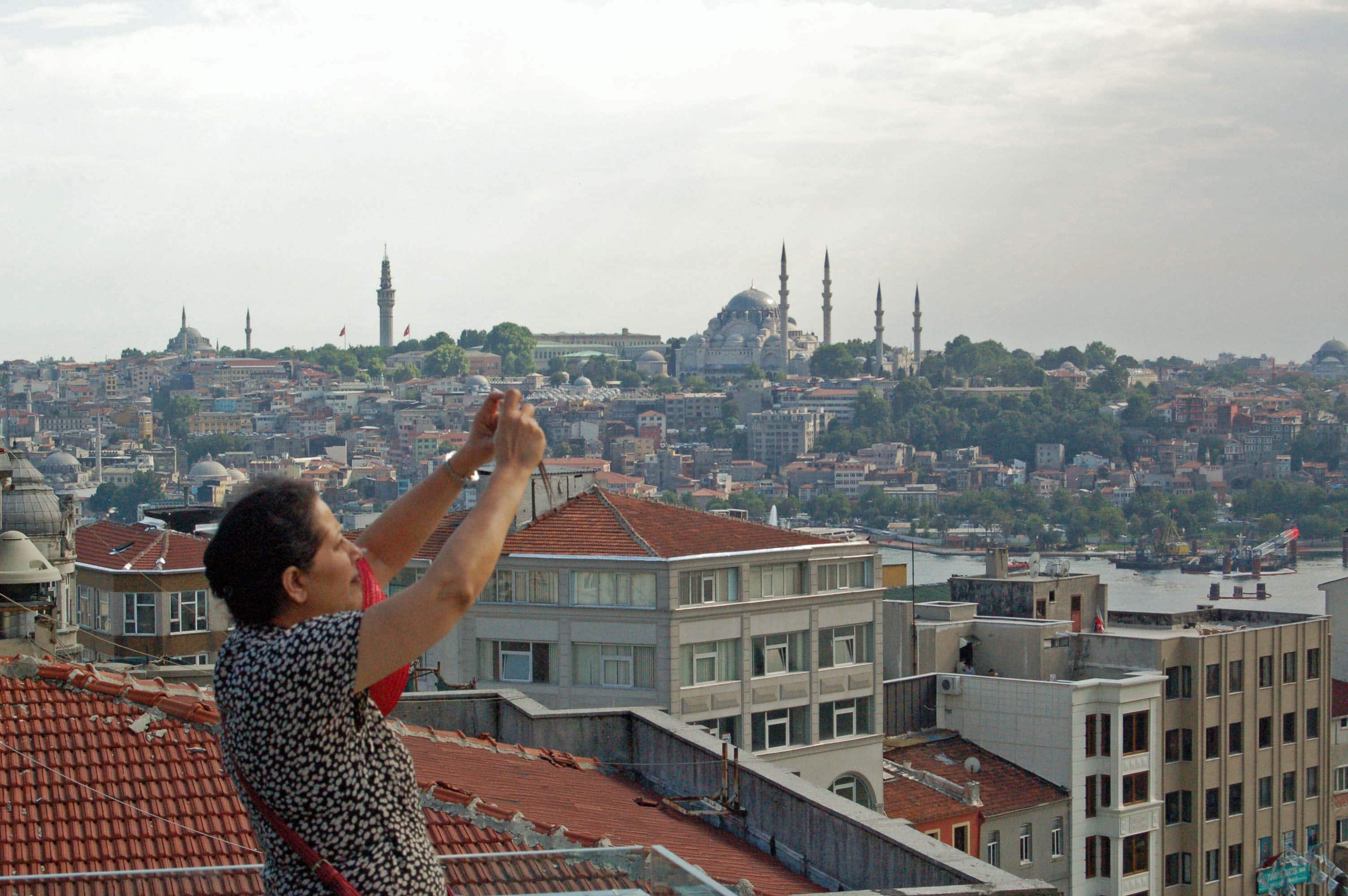
Geeta Mehta taking photos of Istanbul, Turkey while working with local groups demonstrating the social capital of their communities.
How can social capital thinking be expanded to more cities around the world?
The urgent need is to bring social capital to the forefront of urban discourse, academia, and urban design practices. Because too many schools of architecture are simply teaching form-making without focusing on the impact of buildings on the public realm and the people, I’m trying to bring social capital concepts to the fore.
Right now, I have a team of people at Asia Initiatives who are helping implement our concepts of social capital in grassroots projects. The younger generation sees these issues and they see possible outcomes and solutions. I’m so encouraged and optimistic because of this — when I read the very disturbing political news around us at present, it doesn’t get to me.
I am fascinated by Social Capital Credits developed by your organization, Asia Initiatives. I’ve written about a program in Japan called Fureai Kippu, a caring relationship ticket. Is that similar?
It is similar in some ways, except that you earn Social Capital Credits or SoCCs for doing social good, and can redeem them to improve your own wellbeing. There are also other projects that include barter, but they cannot be replicated outside their communities, whereas SoCCs can be localized for any community around the world. It is a bit like the airline loyalty programs, but designed to bring communities together.
So whether you are taking a neighbor’s grandma to the hospital, planting trees, de-silting a pond, or cleaning a river, these are big acts of social good that can be built into the SoCCs Earning Menu.
Each project is developed from the bottom-up, and localized. We don’t go to a community and say, “Let me tell you what to do.” Instead, we say, “What do you think your community needs and what are you willing to do? What do you think that’s worth to the community? And what would you like to get in turn for that that will improve your life?”
You can redeem SoCCs for items of individual good that are in the Redeeming Menu agreed to by the community. Accountability is built into the system; as soon as a task is completed, a SoCC manager verifies it, and people receive credits that go into their account, which can be on paper passbooks or on SoCCmarket.org, our online platform. These days, even poor people are beginning to have access to smartphones, so we think our online platform will become more useful to people in the near future.
What we are doing is making social capital fungible, if you will, and that makes this more universal and usable.
How many people are in the SoCCs program at present and how does it work?
At the moment about 20,000 people are using SoCCs in India, Ghana, Kenya, Costa Rica and USA.
From the outset SoCC projects are owned by the people — not us. We just provide the methodology and initial funding for the things that people want to redeem. We focus on healthcare, education, and skill empowerment. The goal is that, eventually, local CSR players will also step in, and people will begin to trade SoCCs amongst themselves as a barter currency, making the projects sustainable.
SoCCs facilitate and increase the speed of transactions in poor communities, which will help them out of poverty. We are trying to work alongside government organizations in all our projects, and show them how SoCCs can become a way of them to partner with the people in an effective way.
We also have project in Washington, D.C., with our partners, Women Strong International (WSI), and Bread for the City, designed for poor women, most of whom cannot read or write. They are unemployed and have a history of drug or incarceration issues. With our partners, we are trying to improve their condition and make them job-ready, but the minute they get a job, they may risk losing benefits such as food stamps, and, sometimes, housing. So, poverty in this very wealthy country is a complex matter.
How can other organizations partner with Asia Initiatives?
We welcome other organizations or governments to contact us. We can partner with them.. We have manuals, videos, and other tools to help our partners implement SoCCs effectively. Our details can be found through our website www.asiainitiatives.org.
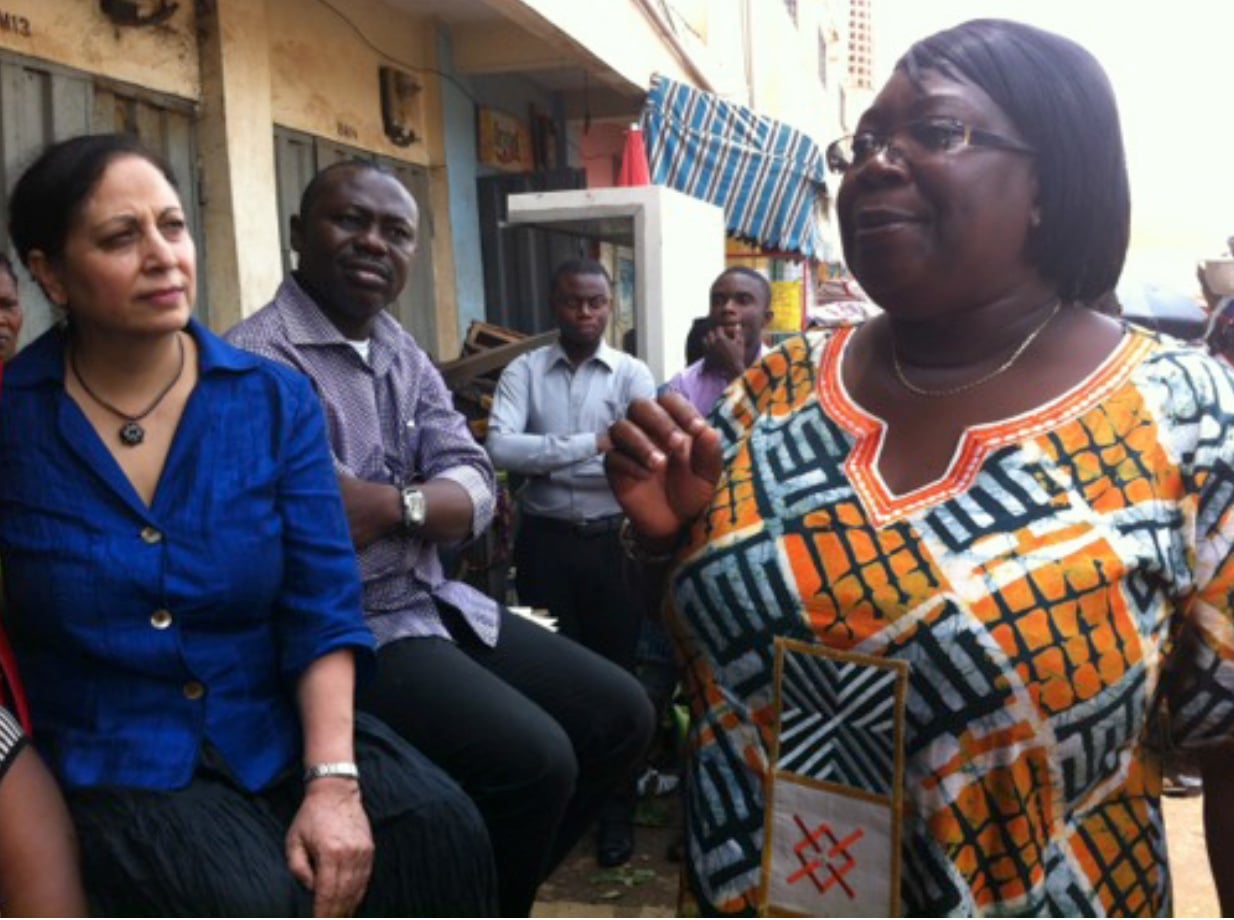
Geeta Mehta launching Social Capital Credits in Ghana (2014).
In your opinion, what would be an ideal organization for you to partner with?
We like to partner with organizations that are working at the grassroots level. The concept of SoCCs is applicable to rich and poor communities alike, so any project is OK.
In Mumbai, we’re planning a project with a middle-income housing estate. Even though the people there have their basic needs met, they don’t have a community, so as people get older, they become isolated. We’re trying to bring them together with younger people and each other. However, our main focus is to help poorer communities where we can.
In Costa Rica, we’re working with the government to multiply the impact of every development dollar the government can spend. Women earn SoCCs for joining neighborhood watch groups to keep their neighborhood and children safe, and the Mayor’s office provides them with Internet and other amenities in exchange for SoCCs. This sort of partnership intensifies the development process and empowers people as stakeholders.
You are also empowering people to say, “Okay this is my problem, I have to solve it, and we can solve it together, using our social capital.”
Disempowerment is to think that you cannot improve your lot in life.
Who has left an imprint on your professional DNA?
In my case, it is Professor M.S. Swaminathan, a renowned agriculture scientist and a humanist. My husband, Krishen, [Former PwC partner, Advisory Board Aspen Institute, and Tax Justice Network] and I used to say, “We have to do something, we owe it to society, we have to give back.” Then we met Prof. Swaminathan in Tokyo, who is the founder of M.S. Swaminathan Research Foundation in Chennai, India. He’s an amazing man — known as the father of Green Revolution in India and Modern Gandhi. He has 84 honorary PhDs and is a recipient of the World Food Prize and the Four Freedoms Medal among other honors. I knew nothing about agriculture at that time, but when we met him, we immediately resonated with his ideas and decided to work together.
Krishen and I visited the MSSRF projects and saw firsthand the impressive work Professor M.S. Swaminathan and his team were doing. We then started a foundation in Japan named Friends of M.S. Swaminathan Foundation (MSSRF). In partnership with MSSRF, we created 200 microcredit banks mentioned before, as well as 40 village knowledge centers.
Working with Professor M.S. Swaminathan was like being in the “university of holistic development.” Just listening to Prof. Swaminathan and seeing their work in the field was an intense learning experience for me for many years.
What ideas has he instilled in you?
Professor M.S. Swaminathan said to me, “Don’t give charity, because giving charity makes somebody a beggar.” You should always be thinking about empowering people to help themselves. I think my concept of SoCCs comes out of that. Because with SoCCs you’re saying, “You do something good and we barter.” In addition, the focus on women which Prof. Swaminathan impressed upon us is the magic key to developments.
What’s next?
Everything is converging quite nicely in my life. My work in architecture and urban design is converging with social capital concepts that I have been developing with Asia Initiatives. My university [Columbia University] is now keen to bring these ideas into our studios and pedagogy.
My architectural and urban design work is also helping form ideas for Asia Initiatives, while URBZ is helping make design ideas more people-centric. Design can make a real difference. I have little interest in designing mansions for the wealthy. It is so much more powerful to change the lives of communities through design — and that’s something.
As an architect at heart, what does “belonging” mean to you?
Belonging is immensely important. It’s about having something bigger than yourself to belong to, believe in, and want to do something for, right? You can think about belonging to your family, your community, your city, and your country, and then the world.
The big belonging is to the world. I was so pleased when President [of France] Macron recently said, “Let’s make the world great again.” That’s really it — belonging should not be narrow. At the end of the day, you belong to the world.
Everything and all the ideas I have, didn’t come from me – they came from the people that I have interacted with. All this is thanks to the social capital around me and so that’s where I should belong, right?

